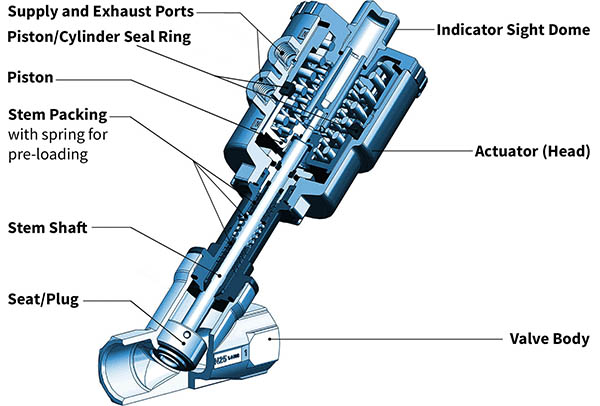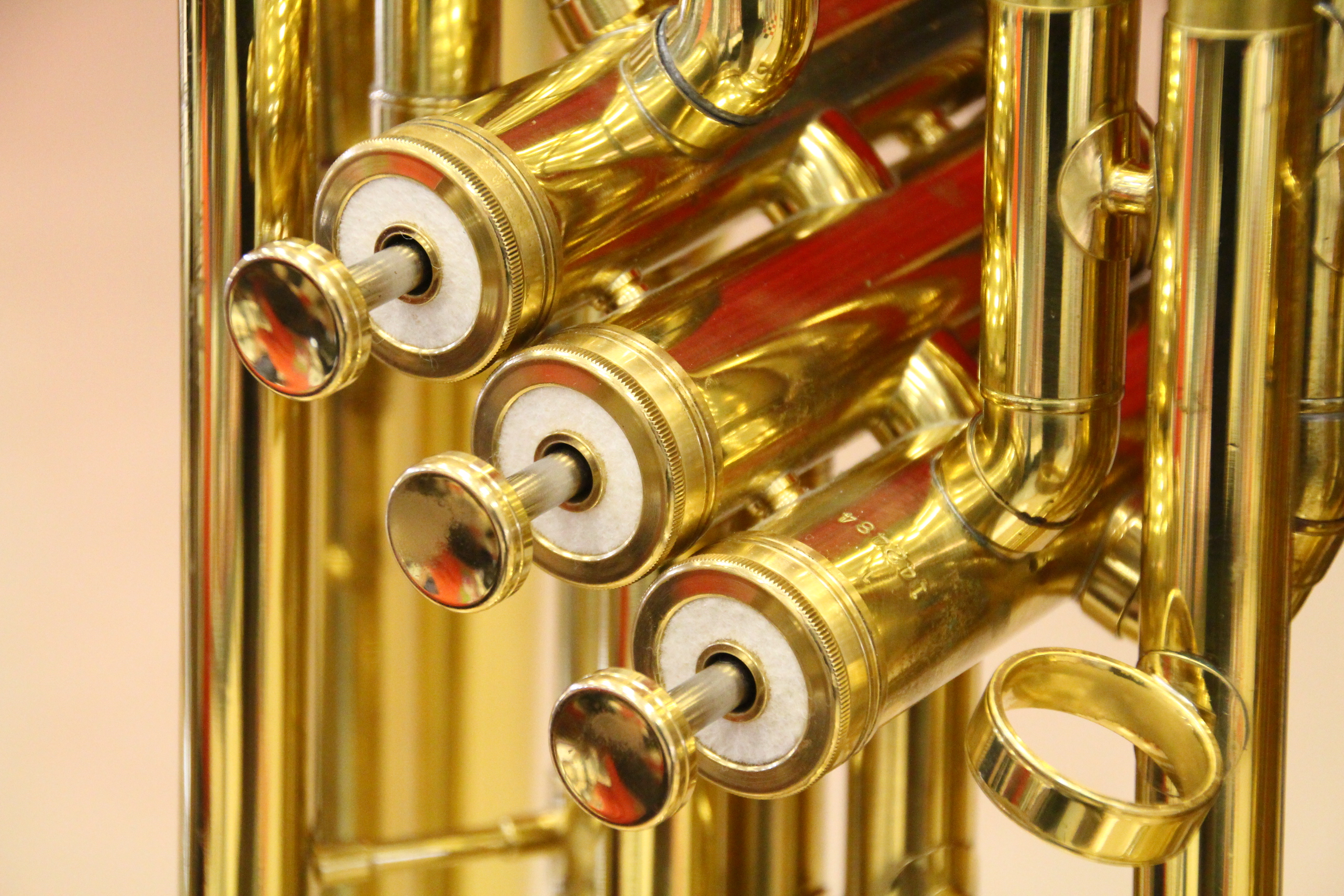|
Piston Valve
A "piston valve" is a device used to control the motion of a fluid along a tube or pipe by means of the linear motion of a piston within a chamber or cylinder. Examples of piston valves are: * The valves used in many brass instruments * The valves used in pneumatic cannons * The valves used in many stationary steam engines and steam locomotives Brass instruments Cylindrical piston valves called Périnet valves (after their inventor François Périnet) are used to change the length of tube in the playing of most brass instruments, particularly the trumpet-like members of the family (cornet, flugelhorn, saxhorn, etc.). Other brass instruments use rotary valves, notably the orchestral horns and many tuba models, but also a number of rotary-valved variants of those brass instruments which more commonly employ piston valves. The first piston-valved musical instruments were developed just after the start of the 19th century. The Stölzel valve (invented by Heinrich Stölzel in ... [...More Info...] [...Related Items...] OR: [Wikipedia] [Google] [Baidu] |
Rotary Valve
A rotary valve (also called rotary-motion valve) is a type of valve in which the rotation of a passage or passages in a transverse plug regulates the flow of liquid or gas through the attached pipes. The common stopcock is the simplest form of rotary valve. Rotary valves have been applied in numerous applications, including: * Changing the pitch of brass instruments. * Controlling the steam and exhaust ports of steam engines, most notably in the Corliss steam engine. * Periodically reversing the flow of air and fuel across the open hearth furnace. * Loading sample on chromatography columns. * Certain types of two-stroke and four-stroke engines. * Most hydraulic automotive power steering control valves. Use in brass instruments In the context of brass instruments, rotary valves are found on horns, trumpets, trombones, flugelhorns, and tubas. The cornet derived from the posthorn, by applying rotary valves to it in the 1820s in France. An alternative to a rotary valve trumpet wou ... [...More Info...] [...Related Items...] OR: [Wikipedia] [Google] [Baidu] |
Valves
A valve is a device or natural object that regulates, directs or controls the flow of a fluid (gases, liquids, fluidized solids, or slurries) by opening, closing, or partially obstructing various passageways. Valves are technically fittings, but are usually discussed as a separate category. In an open valve, fluid flows in a direction from higher pressure to lower pressure. The word is derived from the Latin ''valva'', the moving part of a door, in turn from ''volvere'', to turn, roll. The simplest, and very ancient, valve is simply a freely hinged flap which swings down to obstruct fluid (gas or liquid) flow in one direction, but is pushed up by the flow itself when the flow is moving in the opposite direction. This is called a check valve, as it prevents or "checks" the flow in one direction. Modern control valves may regulate pressure or flow downstream and operate on sophisticated automation systems. Valves have many uses, including controlling water for irrigation, ... [...More Info...] [...Related Items...] OR: [Wikipedia] [Google] [Baidu] |
Angle Seat Piston Valve
{{Unreferenced, date=June 2019, bot=noref (GreenC bot) An angle seat piston valve is a pneumatically-controlled valve with a piston actuator providing linear actuation to lift a seal off its seat. The seat is set at an angle to provide the maximum possible flow when unseated. Angle seat piston valves are particularly suited to applications where high temperatures and large flow rates are required, such as steam or water. When used in reverse some models of angle seat piston valve will eliminate water hammer when operated. Operation Pneumatic valves are operated by a pilot medium under pressure, usually compressed air but also oil or water. The valve is equipped with a pneumatic actuator supplied by a three-way solenoid valve. The pressure of the pilot medium enters the actuator cylinder and acts on the piston, which allows the seal to open or to close through the stem. The return of the seal into its rest position is usually achieved by a return spring that can be found in the ... [...More Info...] [...Related Items...] OR: [Wikipedia] [Google] [Baidu] |
Spool Valve
Spool may refer to: *Bobbin, a cylinder or reel on which a quantity of thread, yarn or wire is wound for use in a particular machine or device *Cable reel, used to carry various types of electrical wires * Spool (record label), active 1998–2008 *Spool (software company), a software company that allows users to save video and text onto their mobile devices to view the content offline *Spool pin, a type of pin used in pin tumbler locks to prevent picking *Simultaneous Peripheral Operation On-Line, Spooling In computing, spooling is a specialized form of multi-programming for the purpose of copying data between different devices. In contemporary systems, it is usually used for mediating between a computer application and a slow peripheral, such a ..., a form of multi-programming for the purpose of copying data between different devices ** The Spooler, an operating system enhancement that provided spooling facilities for some IBM computers * Spool (aeronautics), the unit of rota ... [...More Info...] [...Related Items...] OR: [Wikipedia] [Google] [Baidu] |
Vienna Valve
Brass instrument valves are valves used to change the length of tubing of a brass instrument allowing the player to reach the notes of various harmonic series. Each valve pressed diverts the air stream through additional tubing, individually or in conjunction with other valves. This lengthens the vibrating air column thus lowering the fundamental tone and associated harmonic series produced by the instrument. Valves in brass instruments require regular maintenance and lubrication to ensure fast and reliable movement. Piston valve The first musical instruments with piston valves were developed just after the start of the 19th century. Stölzel valve The first of these types was the Stölzel valve, bearing the name of its inventor Heinrich Stölzel, who first applied these valves to the French horn in 1814. Until that point, there had been no successful valve design, and horn players had to stop off the bell of the instrument, greatly compromising tone quality to achieve a partial ... [...More Info...] [...Related Items...] OR: [Wikipedia] [Google] [Baidu] |
Heinrich Stölzel
Heinrich David Stölzel (7 September 1777 – 16 February 1844) was a German horn player who developed some of the first valves for brass instruments. He developed the first valve for a brass musical instrument, the Stölzel valve, in 1818, and went on to develop various other designs, some jointly with other inventor musicians. Biography Stölzel was born in Schneeberg, Saxony. His father was also a musician, and as a young man he learnt to play numerous instruments, including harp, violin, trumpet and horn. From 1800 he was employed as a military musician for the Duke of Pless, Silesia, mainly playing the horn. During this time, the horn used was essentially a natural horn, which restricted the range of notes that were able to be easily used to only those in the instrument's natural harmonic series, and variations thereof created by using the hand in the bell to alter the pitch. German musicians also used an ''Inventionshorn'', which allowed some further range of notes ... [...More Info...] [...Related Items...] OR: [Wikipedia] [Google] [Baidu] |
Tuba
The tuba (; ) is the lowest-pitched musical instrument in the brass family. As with all brass instruments, the sound is produced by lip vibrationa buzzinto a mouthpiece. It first appeared in the mid-19th century, making it one of the newer instruments in the modern orchestra and concert band. The tuba largely replaced the ophicleide. ''Tuba'' is Latin for "trumpet". A person who plays the tuba is called a tubaist, a tubist, or simply a tuba player. In a British brass band or military band, they are known as bass players. History Prussian Patent No. 19 was granted to Wilhelm Friedrich Wieprecht and Johann Gottfried Moritz (1777–1840) on September 12, 1835 for a "bass tuba" in F1. The original Wieprecht and Moritz instrument used five valves of the Berlinerpumpen type that were the forerunners of the modern piston valve. The first tenor tuba was invented in 1838 by Carl Wilhelm Moritz (1810–1855), son of Johann Gottfried Moritz. The addition of valves made it po ... [...More Info...] [...Related Items...] OR: [Wikipedia] [Google] [Baidu] |
French Horn
The French horn (since the 1930s known simply as the horn in professional music circles) is a brass instrument made of tubing wrapped into a coil with a flared bell. The double horn in F/B (technically a variety of German horn) is the horn most often used by players in professional orchestras and bands, although the descant and triple horn have become increasingly popular. A musician who plays a horn is known as a list of horn players, horn player or hornist. Pitch is controlled through the combination of the following factors: speed of air through the instrument (controlled by the player's lungs and thoracic diaphragm); diameter and tension of lip aperture (by the player's lip muscles—the embouchure) in the mouthpiece; plus, in a modern horn, the operation of Brass instrument valve, valves by the left hand, which route the air into extra sections of tubing. Most horns have lever-operated rotary valves, but some, especially older horns, use piston valves (similar to a trumpet's ... [...More Info...] [...Related Items...] OR: [Wikipedia] [Google] [Baidu] |
Saxhorn
The saxhorn is a family of valved brass instruments that have conical bores and deep cup-shaped mouthpieces. The saxhorn family was developed by Adolphe Sax, who is also known for creating the saxophone family. The sound of the saxhorn has a characteristic mellow tone quality and blends well with other brass. The saxhorn family The saxhorns form a family of seven brass instruments (although at one point ten different sizes seem to have existed). Designed for band use, they are pitched alternately in E and B, like the saxophone group. Modern saxhorns still manufactured and in use: *B soprano saxhorn: flugelhorn *E alto/tenor saxhorn: alto/tenor horn *B baritone saxhorn: baritone horn *The B bass, E bass, and B contrabass saxhorns are basically the same as the modern euphonium, E bass tuba, and BB contrabass tuba, respectively. Historically, much confusion exists as to the nomenclature of the various instruments in different languages. The following table lists the membe ... [...More Info...] [...Related Items...] OR: [Wikipedia] [Google] [Baidu] |
Brass Instrument
A brass instrument is a musical instrument that produces sound by sympathetic vibration of air in a tubular resonator in sympathy with the vibration of the player's lips. Brass instruments are also called labrosones or labrophones, from Latin and Greek elements meaning 'lip' and 'sound'. There are several factors involved in producing different pitches on a brass instrument. Slides, valves, crooks (though they are rarely used today), or keys are used to change vibratory length of tubing, thus changing the available harmonic series, while the player's embouchure, lip tension and air flow serve to select the specific harmonic produced from the available series. The view of most scholars (see organology) is that the term "brass instrument" should be defined by the way the sound is made, as above, and not by whether the instrument is actually made of brass. Thus one finds brass instruments made of wood, like the alphorn, the cornett, the serpent and the didgeridoo, while some ... [...More Info...] [...Related Items...] OR: [Wikipedia] [Google] [Baidu] |






